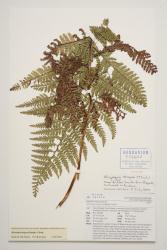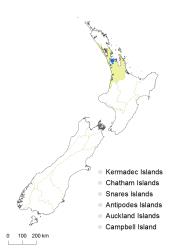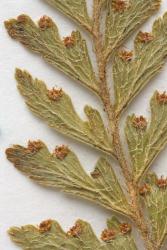- ≡ Trichomanes strigosum Thunb. in Murray, Syst. Veg., ed. 14 (J. A. Murray) 941 (1784)
- = Davallia pinkneyi Colenso, Trans. & Proc. New Zealand Inst. 29: 415 (1897)
- ≡ Microlepia pinkneyi (Colenso) C.Chr., Index Filic. 427 (1906)
Microlepia strigosa has long-creeping rhizomes; fronds 470–950 mm long; stipes yellow-brown to red-brown, 180–350 mm long; laminae 2–3-pinnate-pinnatifid, ovate, 210–510 mm long; the longest primary pinnae 70–200 mm long and 45–70 mm wide. The abaxial surfaces of the rachis, costae and veins bear abundant, colourless or pale brown, multicellular, non-glandular hairs up to 1.2 mm long. The sori are submarginal, and the indusia are half-cup-shaped, attached on three sides, bearing hairs at the base and on the abaxial surface.
North Island: Auckland
Altitudinal range: 40 m.
Known only from one locality in Mt Wellington, Auckland, where it established spontaneously in a garden.
Occurs naturally in India, Sri Lanka, China, south-east Asia, New Caledonia, Vanuatu, Fiji and Hawai‘i.
Recorded as naturalised in a garden and established in the lawn, along a fence-line and under a slat terrace (Heenan et al. 2004).
Heenan et al. (2004). Voucher AK 281050, 2003.
Bartholomew et al. (1997) pointed out that Carl Thunberg’s names in Johan Murray’s Systema vegetabilium of 1784 should be attributed to Thunberg. The correct author citation for Trichomanes strigosum is therefore "Thunb." and not "Thunb. ex Murray".
Davallia pinkneyi was described by Colenso (1897) from a frond collected by Mr Pinkney "in a dry wood near margin of Mangatera Stream, south of Dannevirke; 1895" and grown in his private fernery. The original location was subsequently felled and burnt. Colenso stated that he sent half a fertile frond and two sterile ones to K, and these specimens constitute the holotype (K 000913939). They are annotated in Colenso’s writing "Fern exhibited at meeting, and description drawn up, paper rec’d – for publication next vol.". There are two more sheets in the Cheeseman herbarium (AK 114359–114360), both labelled "Davallia (Microlepia) pinkneyi" in Colenso’s hand-writing and "lower specimen bearing fruit" on AK 114359. There are four sterile fronds and most of a fertile frond, but no indication of locality except for a more recent annotation "Hawkes Bay (probably)". These sheets do not match Colenso’s description of the type and were probably acquired by him later.
Brownlie (1959) examined the specimens at K and identified them as belonging to Microlepia strigosa, which, he said, had been grown in ferneries for at least a century. He suggested that Pinkney may have had exotic as well as native ferns growing in his fernery, and that the origin of the material he gave to Colenso may have been confused. He suggested deleting M. strigosa from the list of indigenous New Zealand ferns. However, if it could be shown that Colenso’s specimen was genuinely naturalised, it would constitute the first record for this species in New Zealand, preceding the current record by over 100 years.






